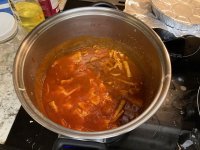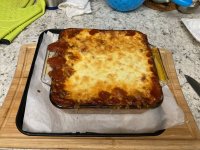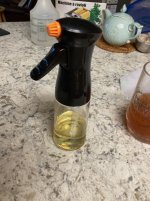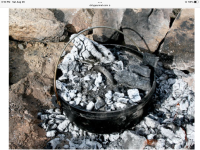I should note at this point that I heel and toe a diesel for giggles 🙂. But I think I understand now where you are coming from. I'm afraid I'm with Cal on the instant pot though 🙂
Close. Avensis. Used to do it on my passat diesel as well. What can I say, kids to cart around.
I have the Kitchen Aid pasta maker and it works quite well. I clean it with the compressor.BTW, I got that fancy Kitchen Aid pasta maker too... I've never used it. My daughter used it once. We get our pasta from... Costco or Trader Joe's.
I use the pasta sheet attachment to make our Slavic treat "crusciki" -- a dough made of flour, egg yolks and rum. The sheet maker is used to produce dough ribbons which are deep fried and dusted with powdered sugar.
Which leads me to an amusing story. My son fried calamari one Easter and reserved the oil. I used thus to fry the crusciki. It was wonderful until a day later when the entire house reeked of fried squid!
I don't think that the Slav forebears fried squid, eel being their preferred digestive vehicle!
Diesel was taxed much lower than gasoline, in fact there was a red colored diesel in England.
Farmers used it for Land Rovers as well.
A diesel generally goes more distance per unit fuel, that was a big advantage on long trips.
Then emission norms became tougher, and the extra cost of owning a maintaining a diesel became harder to justify, now it is over 200k kilometers here.
Even the Europeans had issues, look up 'dieselgate'
Some engines here, 1250 cc / 80 HP class, have injectors a foot long, they coke up, removing them for service means spray and soak for up to THREE DAYS!
And those are expensive to maintain, so the saving in fuel is covered when you need to maintain it.
Compressed Natural Gas is much cheaper to use, and it is a clean fuel, and the engines are quiet. Only issue is limited range.
Light trucks, and increasingly trailers are using CNG, and its cousin LNG.
LNG gives much longer range.
131 F is like 60 C, a very slow simmer temperature, barely warm.
Does it work for pork as well, or less time is needed?
Has anybody tried cooking meat under the ashes of a fireplace or similar?
By that I mean the meat is covered in ash, and the placed under the grate, where coal or wood is burning. So the meat will be exposed to heat, but not flames..
Farmers used it for Land Rovers as well.
A diesel generally goes more distance per unit fuel, that was a big advantage on long trips.
Then emission norms became tougher, and the extra cost of owning a maintaining a diesel became harder to justify, now it is over 200k kilometers here.
Even the Europeans had issues, look up 'dieselgate'
Some engines here, 1250 cc / 80 HP class, have injectors a foot long, they coke up, removing them for service means spray and soak for up to THREE DAYS!
And those are expensive to maintain, so the saving in fuel is covered when you need to maintain it.
Compressed Natural Gas is much cheaper to use, and it is a clean fuel, and the engines are quiet. Only issue is limited range.
Light trucks, and increasingly trailers are using CNG, and its cousin LNG.
LNG gives much longer range.
131 F is like 60 C, a very slow simmer temperature, barely warm.
Does it work for pork as well, or less time is needed?
Has anybody tried cooking meat under the ashes of a fireplace or similar?
By that I mean the meat is covered in ash, and the placed under the grate, where coal or wood is burning. So the meat will be exposed to heat, but not flames..
131F (max... can go to 129F) in sous vide... 48 hours for ribs, 4-9 hour for roasts depending on weight.
140F for pork carnitas... 24 hours.
165F for chicken, 3 hours.
115F for fish. 30 minutes for salmon, 25 minutes for white fishes. finish them on pan with melted butter.
I forget the temps for eggs... it's less than an hour... you can have soft boiled eggs or pasteurized raw eggs.
NG fuel works very well. Our local busses use them, no smoke. We had an NG Civic for a week once.. nice car, Not powerful, but smooth and quiet.
140F for pork carnitas... 24 hours.
165F for chicken, 3 hours.
115F for fish. 30 minutes for salmon, 25 minutes for white fishes. finish them on pan with melted butter.
I forget the temps for eggs... it's less than an hour... you can have soft boiled eggs or pasteurized raw eggs.
NG fuel works very well. Our local busses use them, no smoke. We had an NG Civic for a week once.. nice car, Not powerful, but smooth and quiet.
Last edited:
Braising is the only way I do those, Grilling them leaves you with elastic band beef.turns out daughter bought them at the Korean shop and they are designed for grilling... so they can not be braised... dang it... 65 bucks of ribs!!!
You can't compare the dry stuff with fresh. Two different worlds.Weird he's making that pasta from scratch....
Oui.chacun à son goût,
Cal take OpossumCal will never touch a range top again...
Place on stick
Hold over can of burning diesel
Cal eat.
Cal full.
Cal sleep.
Last edited:
Naresh, the heat and time vary a lot in immersion cooking. The thing to remember is that all the bad living things in meats die eventually when heated. You don't need to bring it to a recommended internal temperature. That is for instant death. Slow death works just as well, it also tenderizes and leaves meat nice and red if that's the way you like it. So Tony's suggestions will work and while different from my way, is still very good at getting where you want to go.
This is not actual, I am just giving you an example of the time it takes to render meat safe.
Chicken Fº
170 - instant death, safe to eat
160 - 5 minutes
150 - 20 minutes
140 - 1 hour
130 - 3 hours
The nice thing about low and slow is just how tender you can make your tougher meats and as mentioned, nice and rare. Finishing is often done over flame as immersion style is often rather bland looking.
This is not actual, I am just giving you an example of the time it takes to render meat safe.
Chicken Fº
170 - instant death, safe to eat
160 - 5 minutes
150 - 20 minutes
140 - 1 hour
130 - 3 hours
The nice thing about low and slow is just how tender you can make your tougher meats and as mentioned, nice and rare. Finishing is often done over flame as immersion style is often rather bland looking.
BTW, the instant pot is the best way to do eggs, especially when doing many. It's fast and the shells fall right off. Not sure why but once you've done them that way, it's hard to go back to the caveman style.
Last edited:
A couple of twin scroll turbo 4X4 SUV's actually, but you were close.Camry drivers likely.
I tend to cook at barely simmer levels, so yes I agree the taste and texture are different from the results of fast cooking.
At the other end, Chinese stir frying techniques are worth looking at, the entire cooking time is very low.
Those dishes would taste quite different if simmered for a long time.
I am being a little pedantic here.
My question was, whether anybody has tried putting meat on a hearth under a fire, and let it cook under the fire, covered in ashes, with the oven floor supporting the food.
I wonder how such meat or vegetables would taste, and the issue of retained moisture as the ashes would tend to dry out the dish if cooked for a long time.
At the other end, Chinese stir frying techniques are worth looking at, the entire cooking time is very low.
Those dishes would taste quite different if simmered for a long time.
I am being a little pedantic here.
My question was, whether anybody has tried putting meat on a hearth under a fire, and let it cook under the fire, covered in ashes, with the oven floor supporting the food.
I wonder how such meat or vegetables would taste, and the issue of retained moisture as the ashes would tend to dry out the dish if cooked for a long time.
We do have a winter dish here, called 'Undhiyo', mixed winter vegetables.
One version is cooked by filling the ingredients in a new earthen pot (it is discarded every time), and placing it upside down in a pit, and a fire is lit from above.
A small saucer like earthenware cover is attached with a ring of dough to the pot to prevent leakage of ingredients.
It takes quite some time to cook, and the results can be seen on internet videos.
I wonder if any other cuisine has such a process, or a similar one.
One version is cooked by filling the ingredients in a new earthen pot (it is discarded every time), and placing it upside down in a pit, and a fire is lit from above.
A small saucer like earthenware cover is attached with a ring of dough to the pot to prevent leakage of ingredients.
It takes quite some time to cook, and the results can be seen on internet videos.
I wonder if any other cuisine has such a process, or a similar one.
Cal: you missed the first step ‘Cal run over opossum on way home’ 🙂
Cal lives in suburbia.... he's just kidding. He gets his opposum from the supermarket.
Braising is the only way I do those, Grilling them leaves you with elastic band beef.
Yakiniku....
Which is the Japanese version of Korean BBQ.
You got to start with great beef though. Marbled like crazy and cut about 1/4 of an inch thick. Thinner and we're talking shabu shabu and sukiyaki, thicker and you're talking braising material....
- Home
- Member Areas
- The Lounge
- The food thread



